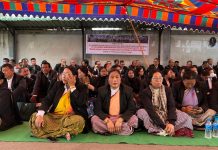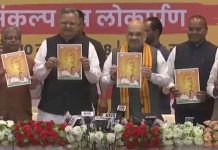A strong Central legislation is the need of the hour as an increasing number of women are being referred to as witches or are becoming the victims of land mafias, writes DR SANGITA LAHA
 Can you believe ‘witch craft’ exists even today? Shocking it may seem but this is a harsh reality. Labelling a woman a ‘dayan’ (witch) is common in the tribal-dominated areas of Jharkhand. My perceptions are based on some gruesome incidents that happened in recent years and were reported.
Can you believe ‘witch craft’ exists even today? Shocking it may seem but this is a harsh reality. Labelling a woman a ‘dayan’ (witch) is common in the tribal-dominated areas of Jharkhand. My perceptions are based on some gruesome incidents that happened in recent years and were reported.
In the eyes of Kochbong village residents, merely 20 kilometers away from Jharkhand’s capital Ranchi, a woman in her early thirties is the reason behind every road accident that occurs on the Ring Road near Namkum block. Savitri Munda is labelled as a ‘dayan’ (witch) by the village residents and her entire family is accused of practicing witchcraft. Economically and infrastructural, Koch bong is one of the better off villages, it has access to pucca roads, there are toilets in every home, and the village even has a school. Superstition, however, is its bane. Not just Savitri, two other women in the village of approximately 250 households have been declared ‘witches’. All three are haunted every day by the fear of a painful death.
On October 9, 2020, three women and a man were allegedly stripped and thrashed by a mob of 50 people who accused them of practising witchcraft and then paraded without clothes throughout the village in the Garhwa district of Jharkhand. Isn’t this a shocking incident?
On March 10, 2021, Times of India reported that three persons, including a woman, were killed in an alleged ‘witch-hunt’ at Haatnada village under Sonua police station in West Singhbhum district of Jharkhand. On 28th March 2021, a 55-year-old woman was lynched, beaten to death by locals at the Lapung area, a community development block of Ranchi district. Some people suspected her of practising witchcraft, killed the woman mercilessly by entering her house.
In another incident, a 60-year-old woman was battered to death while her husband was injured in an attack in Bichkoda village of Jasidih police station area in the district of Deoghar. While a resident of Barewa in the Haidarnagar police station area of Palamu district of Jharkhand, complained of assault and torture against three people. These men had brutally assaulted his mother after accusing her to be a ‘witch’. Several reported cases reveal that a woman accused of a ‘witch’ is subjected to several heart-wrenching cruelties. She is stripped publicly, paraded naked in front of the whole village; her head is shaved off and is made to eat human excreta.
In the state of Jharkhand, tribal communities like Munda, Oraon, Ho, Majhi,Kharia, Birhor, etc., witchcraft are often practiced in cultures, where beliefs regarding paranormal powers, occultism, magical powers, supernatural forces, and black magical powers are deeply ingrained. Murder, driven by the belief in black magic, is common in this state. Gender relationship between the accuser(s) and the accused, plays an important role in the selection of ‘target/s.’ Such attacks are pre-planned and serve as the means for seeking revenge of pre-existent personal conflicts. Men are the decision makers; use such conflicts to serve their ulterior interest of grabbing property, sexual harassment etc. The women are thus the scapegoats in this crafted conspiracy by men.
‘Witch craft’ has different names and are often referred as ‘Churail’, ‘Dayan’, Tohni’ etc. Etymologically the term ‘witchcraft’ is a compound of two words ‘wicce’ and ‘cræft’ wherein the word ‘wicce’ derives its origin from the old English word ‘wicca’ which refers to ‘witch’ and ‘craeft’ denotes ‘skill or ability’. Witchcraft infers to the practice of, and belief in, magical skills and abilities which are believed to influence the mind, body, or property — of others in a malicious manner. The rural locals believe that they possess a supernatural power that hampers other lives.
In the pretext of ‘Witch-hunting’, people kill or rape innocent women to acquire their property. It is also used as a tool for vengeance and to target others in local politics. Though practised secretly nowadays, sometimes the entire village conspires against a household, usually of the Dalit or tribal family — a numerically weaker section in the village. Also, single women, widows, and aged people — the most vulnerable people of the society are chosen for witchcraft and are targeted to capture their land and property.
Most of these women come from backward areas. They are either ‘Adivasis’ or belong to the ‘Dalit’ community. There are many reasons why she could be declared a ‘Dayan’ i.e. witches and many more loaded terms. She is branded on superstitious belief including- if the cow or buffalo stops giving milk or the well dries up, if there is scarcity of water and so on. Or, at times even for reasons like child death while giving birth. They are perceived to cause misfortune, sickness, and even death by casting ‘evil eye’. The suspected witch/es are then subjected to various ordeals to prove their innocence. If unsuccessful, punishments for such acts include chopping off of hands, knocking off the teeth, mouths burnt with hot oil and banishment from the village.
Gender conflict, lack of education, conspiracy against accused women and faith of women being manipulators of super-natural powers for causing illness in the community — act as crucial factors for selecting women as witches. In the identification of witches, physical features like old age, hunch back, or weird hair or skin colour are the pivotal considerations. Usually, anything off-track to the ideally accepted feminine image of ‘good’ can be tendered as reason for labelling as witch.
Witch doctors known as ‘Ojhas’, usually men are called upon to undo the supposedly evil influences of a witch. Unable to cure or heal people, ‘Ojhas’ evade responsibility by claiming the existence of a witch somewhere in the vicinity. One word from an ‘Ojha’ is enough to turn local residents into a frenzied mob out to seek blood-thirsty vengeance and hunt a witch who is usually a weak, lower-caste woman. They claim to do ‘justice’ with her. Many a times, victims and survivors of witch-hunting are also the ones suffering from mental illnesses.
Statistical reality
Reports confirm from 1990 to 2000, 522 women were brutally murdered in the name of being a ‘witch’. The National Crime Records Bureau (NCRB) data further reveals that among the list of states, Jharkhand tops from2013 to 2016 when it comes to witch-hunting deaths and leads in the number of witch-hunts.
Around 523 women were lynched in between 2001- 2016, an alarming figure. In 2019, the state reported 27 deaths related to allegations of witchcraft, as per data provided by the state police, a rise from 18 similar deaths in 2018, according to recently-released National Crime Records Bureau. According to the data covering from the year 2000 to 2019, 1800 women have been killed so far.
The highest number of cases are from the district of Chaibasa and Seraikela, where a total of 233 women were murdered. The Jharkhand Central Bureau of Investigation (CBI) office puts the total number of such murders from 2001 to October 2013 at 414 and cases registered for witchcraft at 2,854. These are statistics which have been logged-in. However the unrecorded ones are anticipated to be far more than this number.
Till 31st July 2020, there have been 18 cases of harassment in the name of ‘Witch Bisahi’. Apart from Jharkhand, at least 11 other states — Haryana, Chhattisgarh, Orissa, West Bengal, Madhya Pradesh, Rajasthan, Andhra Pradesh, Gujarat,
Maharashtra, Assam and Bihar — still report cases of witch-hunting. The country witnessed 63 such murders in 2018 , Madhya Pradesh recorded ten witch-hunt murders, Andhra Pradesh nine, Chhattisgarh eight and Odisha saw five such
killings in 2018, as per National Crime Report Bureau.
The history
The exact date of origin of witch-hunting in India is not known. The practice is said to have emanated hundreds of years ago in the Morigaon district of Assam which is famously called ‘The Indian capital of black magic’.’ Witch-hunting’ is also known as ‘Dayan Pratha’. The earliest evidence of witch-hunt in India is the Santhal witch trials in 1792 in Singhbhum district of Chotonagpur division in India.
The patriarchal mindset of societies is considered to be the cause of the globally common phenomenon of witch-hunting. Caste or Brahmanical patriarchy in India is regarded as to be the main factor behind branding women as witches. Dalit activists claim that witch-hunting is part of caste-atrocities against Dalit women and a
common way to kill them Witch-hunting is a three-stage process viz. ‘accusation’, ‘declaration’, and ‘persecution’. Accusation means and includes
‘accusing women of any harm occurred in the community or to the individual, such as the death of any person, child or animal, any disease in the village, natural disaster, or crop loss.’
Declaration means to declare or brand the woman as a witch as she possesses some evil power, and exclude her socially. The so-called witches are identified through certain rituals by traditional witch-finders or witch doctors, who are variously known as the ‘khonses’, ‘sokha’, ‘janguru’,or ‘ojha’ , and then perpetrators charge them for persecution. Persecution includes mental and physical torture, ranging from social exclusion, name-calling, psychological torture, lynching, or putting to death in any way. The concept of persecution refers to strategic attempts encouraged by dominant and influential groups in society, directed at groups that threaten them. Accusing a Dalit woman of witchcraft and persecuting her is a standard weapon of patriarchal set-up in rural India. It is an acknowledged fact that most of the witch-hunting victims are widows, single, older women, and social-economic marginalized women without any
Legal scenario
There is no specific national level legislation that penalizes witch-hunting. The provisions under Indian Penal Code 1860 can be used as an alternative, and the other sections invoked in such cases are Sec 302 — charge for murder, Sec 307 — attempt for murder, Sec 323 — hurt, Sec 376 — rape and Sec 354 — outraging a woman’s modesty. It is also punishable if due to torture, a woman commits suicide. However, a large number of perpetrators are out on bail, and there is no system to re-arrest them.
Although the practice is prevalent in 12 states of India, only 7 state laws have criminalized it. Jharkhand is one of them. Rajasthan passed a law banning witch-hunting in 2015.In Assam, the Assam Witch-hunting (Prohibition, Prevention and Protection) Bill “mandates a jail term of between three and seven years for branding any person a witch, which may be extended to life imprisonment if the person is driven to commit suicide as a result of being labelled a witch”.
The Bihar government passed a law in 1999 called the Prevention of Witch (Daayan) Practices Act, 1999. Jharkhand followed it with the Anti Witchcraft Act in 2001. The Chhattisgarh Tonhi Pratarna Bill 2005 (Chhattisgarh Prevention of Atrocities on Women in the name of Tonhi) was formulated in 2005. Odisha enacted the prevention of Witch craft act in 2013. The Maharashtra Prevention and Eradication of Human Sacrifice and other Inhuman, Evil and Aghori practices and black magic Act, 2013. The Rajasthan Prevention of Witch-hunting Act, 2015.The Karnataka Prevention and Eradication of Inhuman Evil practices and black magic Act, 2017.All these are state legislations.
Unfortunately, the existing laws have not been able to either tackle such vicious crimes or create fear in the minds of perpetrators. The threat of punishment and conviction hasn’t been a deterrent. On 8th March 2021 the Jharkhand High Court had taken suo motu cognizance of the ‘disturbing’ killings of five members of a family in the state on the basis of a report published by the Times of India, revealing that the village council of Buruhatu-Amatoli mountain sentenced five members of a family to death by declaring them ‘churail’ after which they were murdered.
Because of lack of law or rather toothless laws and their weak implementation, this practice is prevalent even today. The Prevention of Witch-hunting Practices Act came into effect in the state of Jharkhand in 2001, yet the practice of branding women as ‘witches’, ‘churail’ is centuries old in the region. The Prevention of Witch-hunting Practices Act, 2001, is a positive step in the right direction, yet its inadequacies for dealing with severity and scale of the practice of witch-hunting cannot be ignored. What is required now is strong central legislation …..an urgent need of the hour.
The author is an Associate Professor & Dean of the Faculty of National University of Study and Research in Law, Ranchi. Views are personal
tehelkaletters@gmail.com












